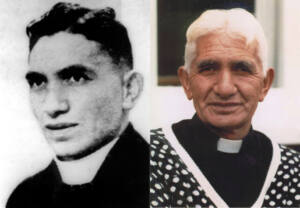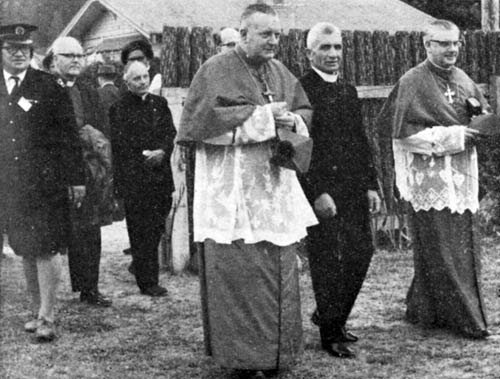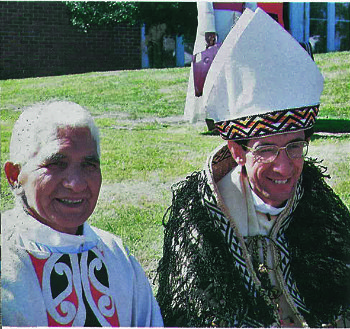NauMai September 2021
First Catholic Māori priest (1914–1994) – Ngāti Maniapoto and Ngāti Hāuaroa

Wiremu Hākopa Toa Te Āwhitu, the first Māori to be ordained as a Catholic priest, was born at Ōkahukura, near Taumarunui, on 28 July 1914. He was the third of 10 children of Tamakaitoa (Toa) Te Āwhitu and his wife, Katarina Toia Bell; Katarina also had four other children from her first marriage. The family’s main tribal affiliations were Ngāti Hāuaroa and Ngāti Maniapoto. From his large immediate and extended families Wiremu learnt the importance of sharing everything and working closely with others.
Te Āwhitu’s maternal grandfather was Alexander Bell, the first non-Māori permitted to settle in Te Rohe Pōtae (the King Country). It was a region steeped in Māori history and folklore, and a land of abundant food. The Ōngarue and Whanganui rivers teemed with eels and other fish; the surrounding native bush provided delicacies now rare and protected, as well as wild pig and deer, pikopiko (fern fronds) and kōmata (pith of the cabbage tree). Life on the family farm helped to shape a man of physical strength, mental tenacity and sheer determination. It also taught him the importance of hard work and left him with a very gentle nature.
Wiremu Te Āwhitu’s early education was at Ōngarue and Ōkahukura schools. The man who most influenced him was RA Watson, known to Māori as Te Miro Wātihana. Watson was an English convert to Catholicism and headmaster at the Ōkahukura School. He also gave the local children their religious lessons, working with the Mill Hill priests. It was to Watson that Tamakaitoa entrusted Wiremu. Through the efforts of Watson and the Mill Hill priests, Wiremu was able to attend St Peter’s Māori College, Northcote, Auckland, in 1931–32. Watson, also now living in Auckland, taught him to master English. Te Āwhitu practised Māori crafts and became a skilled carver and artist.

Te Āwhitu’s desire to become a priest was supported by Watson and the Mill Hill fathers. He attended St Patrick’s College, Silverstream, to begin the usual academic course preparatory to entering the seminary. At St Patrick’s he was an accomplished footballer and athlete and won the award for best Māori student. Here he met Fr JJ Riordan, of the Marist Māori mission staff, who did much to assist him, then and later.
In 1936 Te Āwhitu entered Mount St Mary’s, Greenmeadows, to commence studies for the priesthood. He took temporary vows at Highden Novitiate near Feilding in February 1938, and in March 1941 received minor orders. During 1942 he worked with the Marist Māori missioners on the Whanganui River and in Taranaki. In 1943 he recommenced his studies at Greenmeadows. He was ordained a priest in St Patrick’s Church, Napier, on 17 December 1944 and celebrated his first Mass the following day in the church of the Immaculate Conception at Pakipaki.
Te Āwhitu spent the years 1945–46 at Ōtaki, then spent 11 years at Meeanee and Pakipaki in Hawke’s Bay. He was a member of the Hawke’s Bay Māori mission and his pastoral area extended from Wairoa to Dannevirke. In 1958 he suffered a severe stroke, which left him unable to speak. He spent his convalescence at Hato Pāora College, Feilding, and by 1966 was able to resume his ministry. He spent time at Waitara and Normanby in Taranaki. In 1968 he moved to Jerusalem on the Whanganui River and was there when James K Baxter established his commune. He was one of the poet’s religious instructors, and in 1972 headed the priests celebrating Baxter’s requiem mass.

Wiremu Te Āwhitu retired to Ōkahukura in 1989. He was devoted to the priesthood and all it entails – prayer, hard work, a deep devotion to the Blessed Virgin Mary, and a commitment to his people. He had a gentle, quiet presence, a big heart, a welcoming smile and a spirituality that sprang from the soul of a man at peace with his God and the world. In retirement he provided the impetus to establish Whānau Maria Marae at Ōkahukura.
Wiremu Te Āwhitu died at Waikato Hospital, Hamilton, on 29 July 1994. His tangihanga was held at Ngāpūwaiwaha marae, Taumarunui, and his requiem mass was celebrated in the church of the Immaculate Conception, Taumarunui. He was buried in the family cemetery at Ōkahukura, on the banks of the Ōngarue River
This biography by Bishop Max Takuira Matthew Mariu CNZM (1952–2005), the first Māori Catholic Bishop, and the Auxiliary Bishop of Hamilton (1988–2005), was first published in the Dictionary of New Zealand Biography in 2000.
Source: teara.govt.nz
27th anniversary of Pā Wiremu Te Whitu, Whānau Maria Marae: 31 July 2021
Pā Wiremu Te Awhitu SM was ordained in 1944 as the first Māori Catholic priest. He died 50 years later on 29 July 1994 and is remembered every year by his people on the anniversary of his death. Commemorations for the 27th anniversary of his passing were held on 31 July this year at his home marae, Whānau Maria – Mary’s Family, Okahukura, Taumarunui.
Local whānau and St Patrick’s Taumarunui primary school principal, Brian Belczacki, were joined by Bishop Steve Lowe dd, Bishop for the Hamilton Diocese, and Frs Vince Jones, Taumarunui; Laurie Bishop, Matamata; Pā Jack Smith, Feilding; Fr Gerard Aynsley, Dunedin South; and Frs Arthur Toothill sm and Phil Cody sm.
Nephew of Pā Te Awhitu, Winston Te Awhitu said, ‘We give thanks for our forebear who so bravely linked being fully Māori with being fully Christian.’
After the pōwhiri, the Rosary was led by the Lander family at the nearby urupā. The group returned to the marae for Eucharist and a hākari (festive meal).
Bishop Lowe, the main celebrant at the Memorial Mass, said he hopes Fr Te Awhitu will be a source of faith and inspiration to all in his diocese and indeed all in Aotearoa – New Zealand.
Bishop Lowe drew a parallel between Fr Te Awhitu and St Ignatius Loyola, whose feast-day is 31 July. ‘Both men suffered a life-changing injury – Ignatius through a cannonball, which broke his legs and Te Awhitu through a stroke. Both men worked through their suffering and became ministers to their people. Fr Te Awhitu was able to smile, despite the cross he carried. That is an inspiration for us all.’
At the hākari, Pā Jack Smith said, ‘I owe my vocation to Pā Te Awhitu who worked in my home area of Wairoa.’
In 1958, Pā Te Awhitu suffered a severe stroke that took away his speech. After years of determined effort, he took up ministry again, largely in Taranaki and then 21 years based at Hiruharama, on the upper Whanganui River, where he worked alongside the Sisters of Our Lady of Compassion and befriended James K Baxter, who regularly attended his services.
Pā Te Awhitu retired to Auckland and returned to Okahukura where he worked on building the marae. A new plan to rebuild the complex was unveiled at this year’s anniversary.
Fr Te Awhitu died on 29 July 1994. The first Māori Catholic Bishop, Bishop Tākuira Mariu sm, was at his side. It was a day after his 80th birthday and in his 50th year of Marist priesthood.
Source: Pā Philip Cody sm for CathNews